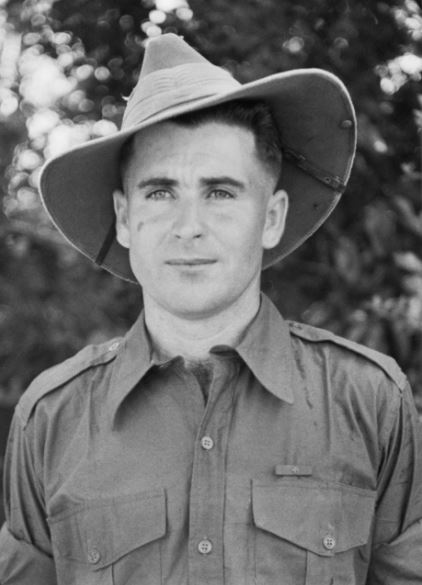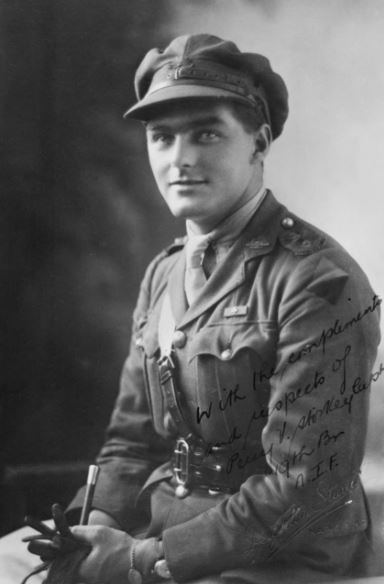Private Leslie Thomas Starcevich VC (1918 - 1989, 71yo)
 Leslie Starcevich was born on 5 September 1918 in Subiaco, Western Australia. After finishing school, he worked in the goldfields before enlisting in the Australian Imperial Force on 9 April 1941. He was posted to the 2/43rd Infantry Battalion.
Leslie Starcevich was born on 5 September 1918 in Subiaco, Western Australia. After finishing school, he worked in the goldfields before enlisting in the Australian Imperial Force on 9 April 1941. He was posted to the 2/43rd Infantry Battalion.
He deployed to the Middle East in September 1941, and during the fighting at Ruin Ridge, El Alamein in July 1942, he was wounded and subsequently returned to Australia. In August, he was assigned to operations in New Guinea. He was promoted to Acting Corporal in December 1942 but later chose to revert to the ranks.
On 27–28 June 1945, during the final stages of the Borneo campaign, Starcevich took part in the assault on Labuan and British North Borneo. Advancing along a narrow jungle track, his company came under fire from a series of concealed enemy positions. When the lead platoon was pinned down, Starcevich stepped forward under heavy fire. Advancing through the forward elements with his Bren gun, he eliminated the first machine-gun post. Confronted by a second, he calmly reloaded in the open and continued his attack, again destroying the enemy emplacement. A third post was engaged jointly by Starcevich and a comrade, who laid down sustained fire until the threat was neutralised. His actions were pivotal in breaking the Japanese defence and allowing the company to advance.
For his extraordinary bravery and disregard for personal safety, Starcevich was awarded the Victoria Cross—the highest honour for gallantry in the face of the enemy.
He returned to Australia in January 1946 and was discharged the following month. In later life, he married twice and settled in Esperance. He passed away on 17 November 1989 at the age of 71 and was buried with full military honours.
Sergeant Percy Clyde Statton VC, MC (1890 - 1959, 69yo)
 Percy Statton was born on 19 October 1890 in Beaconsfield, Tasmania. After finishing school, he worked in manual labour before joining the Australian Imperial Force in March 1916.
Percy Statton was born on 19 October 1890 in Beaconsfield, Tasmania. After finishing school, he worked in manual labour before joining the Australian Imperial Force in March 1916.
Assigned to the 40th Battalion, he deployed to France later that year. Promoted to temporary Sergeant in early 1917 and confirmed in the rank by April, he soon distinguished himself on the battlefield. During the Battle of Messines in June 1917, he braved heavy enemy fire to organise and lead supply parties to the front, earning the Military Cross. Later campaigns saw him wounded and exposed to gas near Villers-Bretonneux.
In August 1918, during an operation near the Proyart–Chuignes road, the 40th Battalion was ordered to advance across open ground. While much of the unit was stalled by intense shelling, Statton’s section reached its target, enabling the remainder of the battalion to press forward. That evening, with the 37th Battalion pinned down by machine-gun fire, Statton took decisive action. Grabbing his Lewis gun, he led three men toward the enemy. Approaching within close range of a German position, he stormed the trench with revolver in hand, neutralising two gun teams. As they moved on, fleeing enemy soldiers were cut down by fire from guns Statton had previously emplaced.
With one man killed and another injured, Statton and the remaining soldier crawled back to safety. Later that night, he returned under cover of darkness to recover the wounded and bring back the fallen. For his extraordinary leadership and courage, he was awarded the Victoria Cross.
Returning to Hobart in November 1919, he received a warm welcome, though his home life had changed—his wife, who had opposed his enlistment, had left during his absence. He later remarried twice and lived a quiet postwar life. Statton died on 5 December 1959 from stomach cancer and was cremated with full military honours.
Captain Percy Valentine Storkey VC (1891 - 1969, 78yo)

Alfred Storkey was born on 9 September 1891 in Napier, New Zealand. He spent his early years working as a clerk before moving to Sydney in 1912, where he joined the University of Sydney’s administrative staff. The following year, he began studying law. Having already served five years with the Wellington Infantry in New Zealand, he brought prior military experience with him when he enlisted in the Australian Imperial Force as a Private on 10 May 1915. He was commissioned as a Second Lieutenant later that year.
Storkey travelled to England with reinforcements for the 19th Battalion and joined the unit in France in November 1916. Promoted to Lieutenant in early 1917, he was later wounded during the fighting around Ypres.
On 7 April 1918, during operations near Villers-Bretonneux, Storkey’s battalion was tasked with clearing a wooded area as part of a larger assault. The company he was second-in-command of was fatigued from previous action and paused at the start line. Storkey, momentarily overcome by exhaustion, was left behind. When he awoke, he ran forward to rejoin his men—only to find that many had already been hit by heavy machine-gun fire.
After the company commander was incapacitated, Storkey assumed control. Leading a small team of soldiers, he moved through dense underbrush to outflank the enemy. With only a handful of men, he reached a clearing behind German trench positions and immediately led a surprise assault. His boldness and initiative caught the enemy off guard—thirty were killed or wounded in the clash, and more than fifty surrendered, believing they faced a much larger force.
For his quick thinking and audacity under fire, Storkey was awarded the Victoria Cross. His leadership in the face of overwhelming odds turned the tide of the engagement and allowed the battalion to secure its objective.
He returned to Australia later that year and was discharged in early 1919. Resuming his legal studies, he was admitted to the bar in 1921. Storkey pursued a career in law, eventually serving as crown prosecutor for the south-western circuit in New South Wales for nearly two decades. He retired in 1955 and passed away on 3 October 1969.
Last Reviewed 06/2025









